From the May 2017 issue of GCM magazine:
Target practices
Although GCSAA’s much-anticipated planning guide for best management practices was released only a few months ago, numerous superintendents have been going down that road for quite a while.
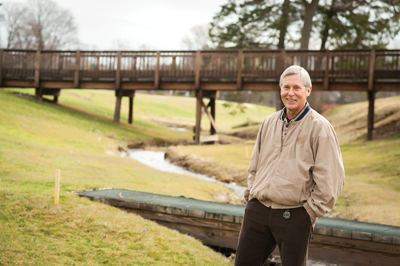
Rick Slattery, CGCS from Locust Hill CC in Pittsford, N.Y., is among the industry leaders when it comes to best management practices (BMPs).
Howard Richman
Read this story in GCM's digital edition »
Rick Slattery, CGCS, welcomed the opportunity to showcase his golf course on a global stage.
Locust Hill Country Club in Pittsford, N.Y., hosted an LPGA event for nearly four decades, a stretch that ended in 2013 after it held four major championships in a row to cap the run. Slattery, who has been at Locust Hill for more than half of those 37 tournaments, has three words as to why having such a high-profile platform meant so much to him.
Best. Management. Practices.
“We were able to show that we could grow high-quality turfgrass with low inputs,” says Slattery, a 32-year GCSAA member.
Earlier this year, GCSAA introduced the “GCSAA Planning Guide & Template,” a powerful online resource for states that pursue the development of BMPs. The association is committed to helping implement BMPs in all 50 states by 2020. Currently, several states with GCSAA-affiliated chapters have BMPs already established, including Florida, Michigan, New York, North Carolina, Oregon, Pennsylvania, Virginia and Washington. “GCSAA’s role in developing BMP programs around the country is inspiring and crucial to the game of golf in the future,” says Slattery.
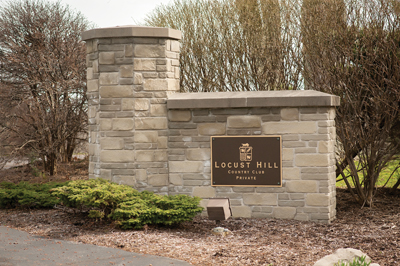
Locust Hill CC is a BMP success story. Slattery has drastically reduced water use, decreased pesticide applications, and has done his part to protect wildlife.
Photos by Mary Corcoran
BMPs serve dual roles. First, they are critical documentation for golf course superintendents to prove, at the least, that they are professional land managers whose actions at their facilities comply with local, state and federal regulations. Second, BMPs are the guidelines that superintendents follow to deliver quality, healthy turf and playing surfaces that meet regulatory requirements in areas such as nutrient use, water management and pest management.
“This BMP platform will help to ensure the ability of golf courses to do business in light of future challenges and opportunities involving water management, use of nutrients and pesticide products,” says Mark Johnson, associate director of environmental programs at GCSAA. “The process allows superintendents to be engaged and proactive by using advocacy and providing educational opportunities about what BMPs do, in lieu of waiting for others to dictate what is proper for golf to do or not do. A lot of superintendents already have been doing these things anyway before the guide and template were introduced.”
Slattery, whose course also participates in the New York Environmental Leaders program, says most templates — GCSAA’s included — have similar philosophies at their core despite taking different approaches. “What all programs have in common can be boiled down to establishing baselines, to having a plan in place to try to gradually lower those baselines, and then being active in education and outreach to spread the message,” he says.
In the following pages, GCM takes a closer look at a handful of superintendents who, like Slattery, are all in on spreading the BMPs message via their actions on the golf course.

Kurt Noonan, CGCS at Juniper GC in Redmond, Ore., invites community members, particularly students, to the golf course so they can learn about the environmentally friendly practices that are part of everyday management at the facility.
Kurt Noonan, CGCS
Juniper Golf Club
Redmond, Ore.
Soil testing is among the top items on the agenda for Kurt Noonan, CGCS — and a key agronomic-fueled BMP initiative. “One thing I learned over time is how important soil tests are. If you feed the soil, it’ll feed the plant,” Noonan says.
BMP-driven practices also serve as a conduit for community outreach. Local junior high students literally build their environmental skills on the course through an after-school program Noonan initiated in which students visit Juniper to construct bluebird boxes for the property. These occasions are an opportunity for Noonan, a 26-year GCSAA member, to enlighten the young audience on some of the environmentally minded practices he employs at his facility.
“Our golf course is an outdoor classroom. Before they leave our facility, we hope it has given them a different perspective on something such as water,” Noonan says. “We let them know how we mitigate it, how it goes back into the aquifer. If they go home and don’t take as long of a shower as they usually do or don’t run the water while they are brushing their teeth, it’s a big benefit for everybody.”
The present is much different from the past in terms of how Noonan views his work space. Part of the proof is that Juniper is now a Certified Audubon Cooperative Sanctuary (GCSAA’s BMP template recommends use of environmental programs such as Audubon’s). “When I was younger, I didn’t know if I could handle all of the restrictions that golf courses are under now,” Noonan says. “BMPs have become part of a routine — part of who you are. Really, it’s about placing restrictions on yourself. It’s not hard. The bottom line is that it’s the right thing to do.”
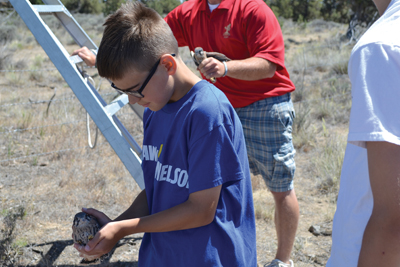
Junior high students help assemble birdhouses
at Juniper GC with an assist from Noonan.
Photos courtesy of Kurt Noonan
Noonan’s community outreach touches many. He pitched a proposal to management to host a 5K run, and it was a runaway hit. Two community runs have been held, and nearly 300 high schoolers participated in two cross-country races on the property. “Some people who didn’t even know where Juniper was do now, and now they know something about us and what we do,” Noonan says.
Ed Harris, whose child has participated in the birdhouse-building activities at Juniper, is among those familiar with Noonan’s advocacy skills. “We tend to be isolated out here, but the course has proven it is more than just golf,” Harris says. “It is a big piece of this community, and he (Noonan) is a massive contributor to our community.”
Andy Jorgensen, CGCS
On Top of the World
Ocala, Fla.
A letter from a member remains a keepsake for Andy Jorgensen.
“In correspondence with our membership, I had outlined our aerification schedule, and let them know what we were doing would affect us for years to come. For one of our members, it was like a lightbulb came on,” says Jorgensen, a certified superintendent and 17-year GCSAA member who oversees 54 holes at On Top of the World. “He wrote to me and said he had disagreed with me on aerification until he read that sentence — that it wasn’t a temporary fix but was for our long-term survival. The message got across.”
Jorgensen is convinced that outreach — whether through targeting club members at On Top of the World or outsiders who may have questions about golf courses and their place in the environment — is vital, and BMPs allow him to state his case anytime, anywhere.
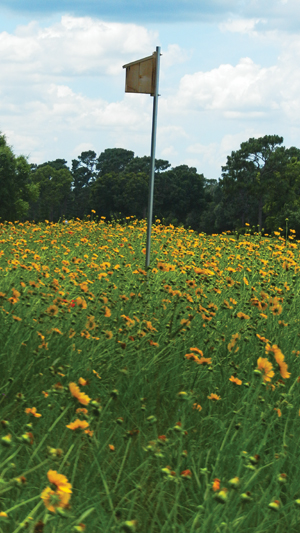
Maintained turf has been replaced by wildflowers at On Top of the World at Ocala, Fla., where Andy Jorgensen, CGCS, is a staunch proponent of BMPs.
Photo courtesy of Andy Jorgensen
“We preach what we do every chance we get — that what we do as superintendents is science-based and not just something that somebody came up with,” says Jorgensen, who also serves as a GCSAA Grassroots Ambassador. “Here, we have been doing BMPs for a long time. Having the documentation to back up what we do helps us plead our case to legislators and policymakers.”
It has proved extremely effective. The Florida GCSA’s BMP manual, which includes a certification program, has kept the state’s superintendents out in front of potential obstacles. Superintendents have encountered more than 90 ordinances in Florida, but they have received exemptions (such as being exempt from blackout periods and restrictions on types of fertilizers that can be used) as well as recognition, thanks to their professional land-management efforts and reliance on the BMP resource.
Jorgensen proudly points out that transitioning to solar power at his maintenance building has saved thousands of dollars. On Top of the World participates in an incentive program as a customer of Duke Energy Florida, which helps the facility use private solar.
There are numerous other examples of BMPs at work at On Top of the World. Jorgensen has abandoned traditional overseeding with perennial ryegrass each fall, opting instead for pigments to color the turf and liquid fertilizers to promote growth. “It has reduced our annual water usage by 21 million gallons per year,” he says. In addition, he has eliminated 3 acres of maintained turf that were out of play and replaced them with wildflowers. “We also partnered with the local beekeeping club, and they have a beehive here on property,” he says.
In the opinion of Mark Kann of the University of Florida’s Plant Science Research and Education Unit, On Top of the World is a perfect example of a BMP success story. “My big thing is being proactive,” says Kann, a 17-year GCSAA member. “Andy is one of the most involved people there is. When he goes to county commission meetings, he doesn’t go to them just for himself. He goes for the industry. He’s protecting jobs for a lot of people, not just his.”
Bill Bieck, CGCS
Heritage Hills Golf Course
McCook, Neb.
When it comes to BMPs, Bill Bieck, CGCS, is ahead of the curve.
Bieck, the golf course operations manager at Heritage Hills Golf Course and a 41-year GCSAA member, has long been proactive to ensure his facility is compliant in every possible capacity. “In the court of law, the old adage is you’re innocent until proven guilty. However, in the court of public perception, it often seems that our industry is guilty until proven innocent,” Bieck says. “BMPs allow us to put out a tool to share with those outside of our industry that we’re doing the right things before we are called into the courtroom.”
Water is the most sensitive issue at Heritage Hills, Bieck says, in part because the golf course sits atop the Ogallala Aquifer and is surrounded by several acres of irrigated farmland. “We disperse water more discreetly, uniformly,” Bieck says.
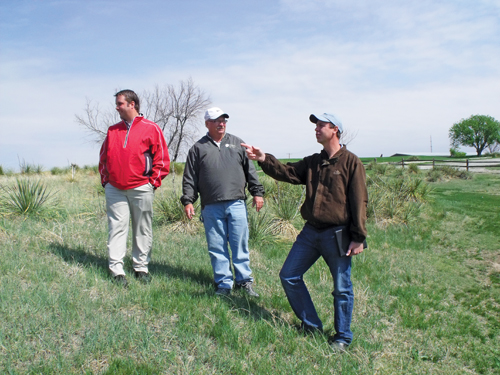
Bill Bieck, CGCS and golf course operations manager (center) at Heritage Hills GC in McCook, Neb., led the campaign to have the course designated a Groundwater Guardian Green Site.
Photo courtesy of Bill Bieck
Outsiders have noticed his achievements. For 10 years, Heritage Hills has held the distinction of being a Groundwater Guardian Green Site in recognition of its environmental stewardship with regard to groundwater. That program, like other environmental management programs, is based upon BMPs similar to those within GCSAA’s template.
“Bill has long advocated for groundwater protection, and practices what he preaches,” says Jennifer Wemhoff, the program communications manager for The Groundwater Foundation, which oversees the Groundwater Guardian Green Site program. “Having partners like Bill in the golf industry is an important component in making us all part of the solution to maintain clean, sustainable groundwater. Golf courses often get a bad rap. The Green Site designation recognizes the good things superintendents are doing to negate impacts on the environment.”
Bieck writes articles and speaks about groundwater protection. He views it as a superintendent’s obligation. “It’s really important to network with entities outside of our comfort zone. It’s really important that we know them and they know us,” Bieck says. “I hope I’ve educated them to a certain degree that we take this seriously and try to do the right things. Our challenges with BMPs may be different here than in Florida, but our end goals are the same.”
Nebraska is targeting 2018 to have its BMPs in place. “I think the (GCSAA) template is great, and am confident most people will be able to navigate the website,” says Bieck, who serves as co-chair of the Nebraska BMP Formation Committee.
Alan Nielsen, CGCS
Royal Oaks Country Club
Vancouver, Wash.

Royal Oaks CC in Vancouver, Wash., provides Alan Nielsen, CGCS, with a platform to be proactive in his BMP plan, which includes a detailed, written maintenance program.
Photo courtesy of Alan Nielsen
Tiger Woods won the Pacific Northwest Golf Association’s amateur championship at Royal Oaks Country Club in 1994. Fifteen years later, Alan Nielsen, CGCS, earned the Oregon GCSA’s Environmental Stewardship Award, which is named in honor of the late Michael Hindahl, Ph.D. (Although Royal Oaks is in Washington, southwest Washington courses like Royal Oaks are under the umbrella of the Oregon GCSA.)
Hindahl was the brains behind the BMP manual shared by Oregon and Washington, which is what Nielsen uses as his template. “A number of government policies and rules were incorporated into this notebook, which help give us credibility when working with local government regulators,” Nielsen says. “The key to developing BMPs is to have a detailed, written maintenance program that addresses concerns about regulations that may impact the facility. I think it’s important to be proactive rather than reactive.”
He makes good on that statement, according to Charles Ray, an urban forester for the city of Vancouver’s public works/environmental division. “Alan Nielsen’s long-term management of the greens and landscape at Royal Oaks shows,” Ray says. “It takes a lifetime to grow a tree, and less than a day to remove one. Royal Oaks has a mature landscape with grand trees due to thoughtful planning and stewardship that occurred years ago and continues today for current and future members.”
Nielsen, who guides school tours of Royal Oaks and hosts a Father’s Day fishing derby with course ponds stocked with trout, says he is simply doing his job.
“It is a big part of my job to make myself available, promote what we’re doing here. You can’t hide in the maintenance shop,” says Nielsen, a 38-year member of GCSAA. “We constantly have to let people know the environment is important to us, and make sure other people know it’s important.”
Terry Vassey, Ph.D.
Old Ranch Country Club
Seal Beach, Calif.
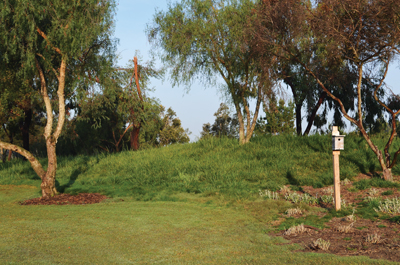
Terry Vassey, Ph.D. , the superintendent at Old Ranch CC in Seal Beach, Calif., has reduced irrigation inputs by 26 percent.
Photo courtesy of Terry Vassey
As a former assistant professor at Cal Poly State University, San Luis Obispo, Terry Vassey, Ph.D., is comfortable speaking to large groups. His ability to tackle the task still comes in handy.
“I’ve made two presentations on BMPs here,” says Vassey, a 22-year GCSAA member who oversees Old Ranch Country Club as its Class A superintendent. “They were well received, and I had lots of questions asked. BMPs are going to lend legitimacy to legislators and other important people. We, at some point, have been vilified as toxic waste dumps, and that we waste water. We’ve come a long way in demonstrating that we aren’t that.”
In drought-challenged California, Vassey deals daily with regulations. “I keep notebooks on everything — gasoline, making sure drainage ways are clear, you name it. We’ve reduced irrigation by 26 percent. I have to tell my members that brown is a color.
“Advocacy with members and those outside of here is very important,” Vassey says. “Not doing it, really, is going backward.”
The final word
At Locust Hill in New York, Slattery can check off multiple boxes when it comes to BMP-themed successes. He has reduced water use by 75 percent, which is just one of his cost-saving measures. Annually, Slattery has lowered pesticide costs by 60 percent, and he currently spends $17,000 on pesticides, $7,000 on growth regulators, and $2,000 on wetting agents.
“When he came here, Rick explained exactly why, and how, he would make the turf healthy, save on labor, money and time in the long term,” says Locust Hill PGA professional Steve Barber. “He explained to membership that just because grass is green doesn’t necessarily mean it’s healthy. That’s a hard sell. To his credit, he stood his ground. He could get a little warm under the collar to get his point across. He’s a cutting-edge guy.”
As an Audubon Steward, Slattery shares his BMP-promoting message often. “He talks about the scientific benefit of what he’s accomplished, and not just to the golf industry, but also to his community, his world. That’s critical,” says Tara Donadio, director of Cooperative Sanctuary programs for Audubon International.
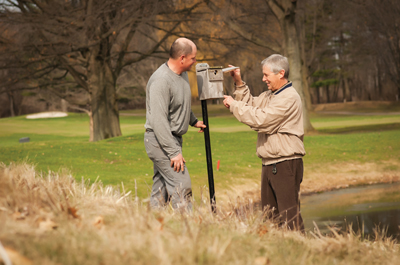
Slattery (right) felt his efforts to implement BMPs were validated when eastern bluebirds made his golf course their home.
Photo by Mary Corcoran
On Easter morning three years ago, Slattery toured his golf course in solitude. The early drive-by is routine for him. Typical, in fact.
Hey, typical — meet extraordinary.
“I noticed a male eastern bluebird sitting on one of my bird boxes,” Slattery says. “I had done some research, and I realized how particular they are about the sites they choose. I went on to have my first successful bluebird family in that box that I saw the bluebird sitting on top of on that Easter morning. It was a magical moment.
“For much of my career, I had been attempting to attract eastern bluebirds to the nest boxes on the golf courses I worked at, without much success. I always thought of them as my ‘canary in the coal mine.’ I figured if I could get them to nest on the golf course, then that would be nature’s verification that I was doing the right things.”
It also told Slattery that three letters — BMP — spell hope for golf. Overcoming the related challenges will take education and commitment for superintendents, but Slattery deems even the attempt itself worthwhile. “Your advice on the GCSAA website to just get started and go after the low-hanging fruit is perfect,” he says.
Howard Richman is GCM’s associate editor.